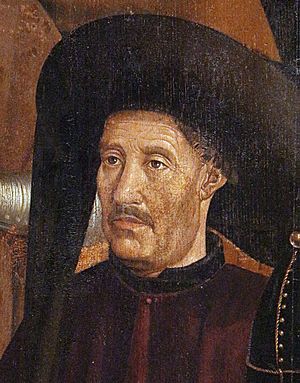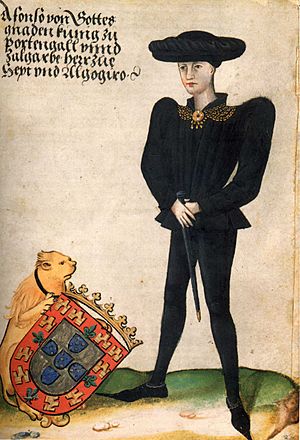History of Portugal (1415–1578) facts for kids
Quick facts for kids
Kingdom of
Portugal and the Algarves Reyno de Portugal et dos Algarues (Old Modern Portuguese)
|
|||||||||
|---|---|---|---|---|---|---|---|---|---|
| 1415–1580 | |||||||||
|
Flag (1485–1495)
|
|||||||||
| Capital | Lisbon | ||||||||
| Common languages | Galician-Portuguese, Old Modern Portuguese | ||||||||
| Religion | Roman Catholic | ||||||||
| Demonym(s) | Portuguese | ||||||||
| Government | Absolute Monarchy | ||||||||
| Monarch | |||||||||
|
• 1415–1433
|
João I (first) | ||||||||
|
• 1578–1580
|
Henrique I (last) | ||||||||
| History | |||||||||
| 14 August 1415 | |||||||||
| 4 August 1578 | |||||||||
| 31 January 1580 | |||||||||
| Currency | Portuguese dinheiro, Portuguese real | ||||||||
| ISO 3166 code | PT | ||||||||
|
|||||||||
The history of the Kingdom of Portugal from the early 15th century to the late 16th century is often called the "Portuguese golden age." It was also known as the "Portuguese Renaissance." During this time, Portugal became the first European country to build a large colonial empire.
Portuguese sailors and explorers made amazing discoveries during the Age of Exploration. They found a sea route to India by sailing around the Cape of Good Hope. They also discovered and settled islands like the Azores, Madeira, and Cape Verde. They explored the coasts of Africa and Brazil.
These explorers also traveled across the Indian Ocean. They set up important trading routes throughout southern Asia. They even sent the first European trade and diplomatic missions to Ming China and Japan. They built trading posts and a key colony in Portuguese Macau in East Asia. This period also saw many great Portuguese poets, historians, and thinkers.
Contents
King John I's Reign
John I of Portugal became king in 1390. He ruled peacefully and focused on making his country's economy stronger. His main military action was taking the city of Ceuta in 1415. This helped Portugal control shipping along the African coast.
Taking Ceuta was a big step. It opened up the Arab world to Europe and led to the Age of Discovery. Portuguese explorers then sailed all over the world.
Writers from that time described John I as smart and kind. He wanted to keep power for himself but was also fair. He loved learning and culture, and his sons shared this passion. They were known as the "illustrious generation."
- Edward, who would become king, was a poet and writer.
- Peter, the Duke of Coimbra, was one of the most educated princes.
- Prince Henry the Navigator invested a lot in science and sea travel.
In 1430, John's daughter, Isabella, married Philip the Good, Duke of Burgundy. She enjoyed a very rich court life and was the mother of Charles the Bold.
King Edward's Challenges
Under King Edward, the colony in Ceuta became very expensive for Portugal. People realized that owning Ceuta was not useful without also having Tangier. In 1437, Edward's brothers, Henry and Ferdinand, convinced him to attack the Marinid sultanate of Morocco.
Not everyone agreed with this plan. Prince Peter and Prince John thought it was better to avoid fighting the Moroccan king. They were right. The attack on Tangier, led by Henry, was a disaster. The Portuguese failed to take the city. Their camp was surrounded by a Moroccan army, and they had to surrender.
Henry promised to give Ceuta back to the Moroccans so the Portuguese army could leave safely. Edward's youngest brother, Ferdinand, was given as a hostage until Ceuta was returned. Ferdinand died in captivity in 1443.
King Afonso V and New Lands
During this time, Portugal continued to settle the Azores and Madeira islands. They started producing sugar and wine there. The gold brought back from Guinea also made Portuguese trade grow. It was clear that these voyages were very profitable, not just for religion or science.
Under King Afonso V (1443–1481), called "the African," Portuguese explorers went as far as Cape St Catherine in the Gulf of Guinea. He also sent three expeditions to Morocco. In 1471, they captured Arzila and Tangier from the Moors.
Under King John II (1481–1495), the fortress of São Jorge da Mina was built to protect the Guinea trade. Diogo Cão discovered the Congo River in 1482. He reached Cape Cross in 1486. Bartolomeu Dias sailed around the Cape of Good Hope in 1488. This proved that the Indian Ocean could be reached by sea.
Treaty of Tordesillas
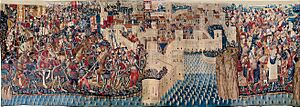
After Christopher Columbus arrived in the West Indies in 1492, Spain and Portugal needed to divide their new exploration areas. This was done with the Treaty of Tordesillas on June 7, 1494.
The treaty drew a line from the North Pole to the South Pole. It was 370 leagues west of Cape Verde. Portugal got all lands discovered east of this line. Spain received all lands discovered west of it.
Measuring longitude was not very accurate back then. So, the exact line was hard to find. This led to different interpretations of the treaty. Portugal used it to claim Brazil, and Spain used it to claim the Moluccas. The treaty showed how important Portugal had become. This importance grew even more when Vasco da Gama completed his voyage to India in 1497–1499.
Some historians believe John II might have known about Brazil and North America as early as 1480. This could explain why he wanted the treaty line moved further west. Many old Portuguese records were lost in the Lisbon earthquake of 1755. However, some important documents about Portuguese explorations were saved. They are now part of UNESCO’s Memory of the World Register.
Royal Power and Nobles
While Portugal gained new lands, the king's power at home was weakened by powerful nobles. After King Edward died, his brother, Prince Pedro, tried to limit the nobles' power. He was the regent while Afonso V was a child (1439–1448).
The leader of the nobles was the Duke of Braganza. He managed to get the king's support and had the regent dismissed. This led to a civil war. On May 20, 1449, Prince Pedro was defeated and killed at the Battle of Alfarrobeira. After this, the nobles were given even more land and power. The Braganza family alone owned about a third of the whole kingdom.
Afonso V also made some mistakes in foreign policy. He married his niece, Joanna, and claimed the kingdom of Castile in her name. He fought an undecided battle at Battle of Toro in 1476. This made him realize he could not take the Castilian throne. However, Portugal won the naval war against Castile (1475–79). They captured a large Castilian fleet full of gold in the Battle of Guinea (1478).
In 1479, Ferdinand and Isabella of Spain and Afonso V signed the Treaty of Alcáçovas. This treaty sent Joanna to a convent. Portugal gained control over the Atlantic Ocean.
His successor, John II (1481–1495), focused on alliances with Castile and friendship with England. He saw that previous kings had given away too much land to the nobles. He decided to take back royal control and seize their territories.
In 1481, the Portuguese Cortes (a type of parliament) allowed royal judges to handle justice in noble lands. The nobles resisted this. But their leader, Fernando II, Duke of Braganza, was executed in 1483. In 1484, the king killed his own brother-in-law, Diogo, Duke of Viseu. Eighty other nobles were also executed. This way, John, called "the Perfect," made sure the Crown was supreme.
He was followed in 1495 by Manuel I, known as "the Great" or "the Fortunate." During his reign, the sea route to India was discovered, and the Portuguese Empire began.
Growing Empire (1481–1557)
King John II (ruled 1481–1495) brought back the focus on Atlantic exploration. He continued the work of his great-uncle, Henry the Navigator. Portuguese explorations were his main goal. He pushed south along the African coast to find a sea route to India. This would help Portugal get into the valuable spice trade.
Manuel I (ruled 1495–1521) was a good successor to John II. He supported more explorations and helped Portuguese trade grow.
Under John III (ruled 1521–1557), Portuguese lands expanded in Asia and the New World. This included the colonization of Brazil. John III made sure Portugal's bases in India, like Goa, were strong. This helped Portugal control the trade of cloves and nutmeg from the Maluku Islands. Because of this, John III was called the "Grocer King."
When he died in 1557, the Portuguese empire covered almost 1 billion acres. During his rule, the Portuguese were the first Europeans to meet people from both China and Japan. John III decided to focus on trade with India and Brazil instead of Muslim lands in North Africa. He also improved relations with countries in Europe to boost trade.
King Sebastian I
Sebastian of Portugal was one of the last kings from the House of Aviz. He became king at age three after his grandfather, King John III, died. His mother, Joanna of Spain, left him to serve as regent in Spain. She never saw him again.
Because Sebastian was so young, his grandmother, Catherine of Austria, and then his great-uncle, Cardinal Henry, ruled for him. During this time, Portugal continued to expand its colonies in Angola, Mozambique, and Malacca. Macau was also added in 1557.
When Sebastian started ruling on his own, he made stronger ties with other European countries. He also changed many parts of his kingdom's government, laws, and military.
- In 1568, Sebastian created scholarships for students to study medicine.
- In 1569, he ordered all laws to be collected into a book called Código Sebastiânico.
- During a big plague in Lisbon in 1569, Sebastian brought doctors from Spain. He also created hospitals and shelters for those affected, especially for widows and orphans.
- He made new laws for the military, called Lei das Armas, which became a model for military organization.
- In 1570, the Indian army attacked Goa, but the Portuguese fought them off.
- Also in 1570, Sebastian ordered that Brazilian Indians should not be used as slaves.
- In 1576, he started Celeiros Comuns (Communal Granaries). These helped poor farmers by lending them seeds and goods when their crops failed.
- In 1577, Sebastian's new law, Da nova ordem do juízo, made legal actions faster.
Sebastian disappeared in the battle of Alcácer Quibir in 1578. He was likely killed in action. After a short rule by King Henry, this led to a crisis over who would be the next king.
Crisis and Union with Spain
After the Portuguese crisis of succession, the crowns of Castile, Portugal, and Aragon were joined. Their colonies also came under the rule of the Habsburg family from Spain.
Uniting the Iberian Peninsula had been a long-term goal for the kings of the region. They wanted to bring back the old Visigothic monarchy.
The time from the crisis in 1578 to the first kings of the Braganza Dynasty was a period of change for Portugal. The Portuguese Empire's spice trade was at its peak. It continued to be very powerful after Vasco da Gama found the sea route to the East in 1497–98.
Portuguese Explorations
Why Portugal Explored
Portugal has a long coastline with many harbors and rivers flowing into the Atlantic Ocean. This was perfect for raising generations of brave sailors. As a seafaring nation in the southwest of Europe, the Portuguese naturally became leaders in exploration during the Middle Ages.
Portugal could reach other European markets by sea or by land. Going by sea meant using their sailing skills. Going by land meant crossing the lands of Castile and Aragon. So, it made sense to send goods by sea to England, Flanders, Italy, and other trading towns.
Portugal had fought hard to stay independent. Its leaders also wanted new conquests. They had a long history of fighting to remove the Moors. This fight was supported by religion and influenced by foreign crusaders who wanted fame. Fighting Islam seemed like their destiny and duty as Christians.
One big reason for exploration was to avoid expensive eastern trade routes. These routes were controlled first by Venice and Genoa, and then by the Ottoman Empire after Constantinople fell in 1453. This blocked European access to goods like spices and silk. Spices were very important for medicine and preserving food.
The Portuguese economy also benefited from its connections with nearby Muslim states. Money was widely used, and workers were paid in currency. Farming became more varied. Grain was imported from Morocco, while vineyards, olives, and sugar factories grew in Portugal. The Aviz kings, who came to power in 1385, also helped reduce the power of the land-owning nobles.
Portugal became a center for knowledge and technology. Thanks to its ties with Islamic kingdoms, many mathematicians and naval experts came to Portugal. The Portuguese government encouraged this. They created important research centers where Portuguese and foreign experts made breakthroughs in math, map-making, and ship technology. Places like Sagres and Lagos became famous for this.
Portuguese Sea Science
As expeditions continued, Portuguese sea science quickly grew. This created a group of skilled astronomers, navigators, mathematicians, and cartographers. Among them were Pedro Nunes, who studied how to find latitude using stars, and João de Castro.
Ships
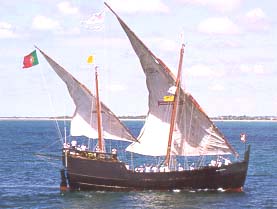
Before the 15th century, Portuguese sailors mostly stayed close to the coast. They used small, fragile boats called barques and barinels. These boats had one mast with a fixed square sail. They were not strong enough for long ocean voyages. Strong winds and currents could easily overwhelm them. These early boats were used for discoveries like the Madeira and Azores islands. They also explored the African coast down to Arguim.
The ship that truly started the first phase of Portuguese discoveries was the caravel. It was based on existing fishing boats. Caravels were agile and easier to steer. They weighed 50 to 160 tons and had 1 to 3 masts with triangular sails. These sails allowed them to sail against the wind more easily. Their main drawbacks were limited space for cargo and crew. But this was okay at first, as they were mainly for exploration. Famous caravels include Berrio and Caravela Annunciation.
As long ocean voyages became common, larger ships were developed. "Nau" was an old Portuguese word for any large ship, especially merchant ships. Because of piracy, these ships began to be used in the navy. They were fitted with cannons. They also grew in size for more trade. From 200 tons in the 15th century, they reached 500 tons in the 16th century. They usually had two decks, castles at the front and back, and two to four masts with overlapping sails. For trips to India in the 16th century, large merchant ships called carracks were used. These could reach 2000 tons.
By the 13th century, sailors knew how to navigate using the sun's position. The Portuguese, like other Europeans, used Arab navigation tools. These included the astrolabe and quadrant, which they made simpler. They also created the cross-staff to measure the height of the sun and stars at sea.
When they reached the Southern Hemisphere in 1471, the Southern Cross constellation became a new guide. But results changed throughout the year, so corrections were needed. For this, the Portuguese used astronomical tables (Ephemeris). These tables were vital for ocean navigation and became very common in the 15th century. They allowed sailors to calculate their latitude. The tables by astronomer Abraham Zacuto, published in 1496, were used by Vasco da Gama and Pedro Álvares Cabral.
Sailing Techniques

Besides exploring coasts, the Portuguese also sailed far into the ocean. They gathered information about winds and currents. They learned about the trade winds and the large oceanic gyres in the Atlantic. Knowing these patterns and how to find latitude helped them discover the best way to return from Africa. This route involved sailing across the Central Atlantic to the latitude of the Azores. There, they used the constant favorable winds and currents that spin clockwise in the Northern Hemisphere. This made the trip back to Lisbon much easier. This sailing trick became known as the "volta do mar" (return of the sea). It allowed the Portuguese to venture further and further from shore.
Cartography
It is believed that Jehuda Cresques, son of a famous mapmaker, worked for Prince Henry. The oldest signed Portuguese sea chart was made by Pedro Reinel in 1485. It showed Western Europe and parts of Africa, based on explorations by Diogo Cão. Reinel also made the first nautical chart with latitude lines in 1504. He was also the first to show a Wind rose on a map.
Pedro Reinel, his son Jorge Reinel, and Lopo Homem worked together on the "Miller Atlas" in 1519. They were considered the best mapmakers of their time. Even Emperor Charles V wanted them to work for him. In 1517, King Manuel I of Portugal gave Lopo Homem the right to check and fix all compasses on ships.
Later, Portuguese mapmaking became even more accurate. Fernão Vaz Dourado (around 1520–1580) is known for his beautiful and high-quality maps. Many of his charts were very large and detailed.
Prince Henry the Navigator was key to coordinating and using all these efforts to expand. He used the vast resources of the Order of Christ, which he led. He also gathered the best information, instruments, and maps.
Henry hoped to find the Christian Empire of "Prester John" by way of the "Western Nile" (Sénégal River). He wanted to team up with this ruler to defeat the Turks and free the Holy Land. The idea of a sea route to India came about after Henry's death.
On land, Henry again defeated the Moors who tried to retake Ceuta in 1418. But in an expedition to Tangier in 1437, the Portuguese army was defeated. They could only escape by giving Prince Ferdinand, the king's youngest brother, as a hostage. Ferdinand, known as "the Constant" for his strength in captivity, died in 1443.
By sea, Prince Henry's captains continued exploring Africa and the Atlantic Ocean.
- In 1433, Cape Bojador was rounded.
- In 1434, the first group of slaves was brought to Lisbon. Slave trading became very profitable until the route to India was found.
- The Senegal River was reached in 1445.
- Cape Verde was passed in the same year.
- In 1446, Álvaro Fernandes reached almost to Sierra Leone. This was probably the farthest point reached before Henry died in 1460.
Portuguese sailors also made voyages westward. They discovered the Sargasso Sea and might have seen the shores of Nova Scotia before 1492.
Portuguese in Asia
It was a huge challenge for Portugal, with only about one million people, to settle and keep control of lands scattered across Africa, its islands, Brazil, India, and other Asian territories like Sri Lanka, Malaysia, Japan, China, Indonesia, and Timor.
There was also constant competition from Spain. This led Portugal to keep their trade routes and colonies secret. As a result, many documents sent to other European countries were fake. They had false dates and facts to mislead other nations.
Key Portuguese Discoveries (1415–1543)
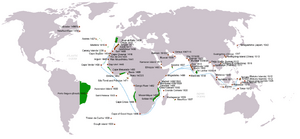
Here are some of the most important Portuguese discoveries:
- 1415: Portugal conquers Ceuta in North Africa.
- 1419: João Gonçalves Zarco and Tristão Vaz Teixeira discover Porto Santo island (Madeira group).
- 1420: The same sailors discover Madeira island, which is soon settled.
- 1427: Diogo de Silves discovers the Azores.
- 1434: Gil Eanes sails around Cape Bojador, a feared point on the African coast.
- 1441: Nuno Tristão reaches Cape White.
- 1444: Dinis Dias reaches Cape Green (Cabo Verde).
- 1445: Álvaro Fernandes sails beyond Cabo Verde.
- 1460: Henry the Navigator dies. His efforts led to mapping the Atlantic up to 8° N on the African Coast.
- 1471: João de Santarém and Pedro Escobar cross the Equator. They discover the Southern Cross constellation, which helps with navigation in the Southern Hemisphere. They also discover São Tomé and Príncipe.
- 1479: The Treaty of Alcáçovas gives Portugal control of the Azores, Guinea, ElMina, Madeira, and Cape Verde Islands.
- 1482: Diogo Cão reaches the mouth of the Zaire (Congo) River.
- 1488: Bartolomeu Dias sails around the Cape of Good Hope, proving the Indian Ocean can be reached by sea.
- 1494: The Treaty of Tordesillas divides the newly discovered world between Portugal and Spain.
- 1498: Vasco da Gama leads the first fleet around Africa to India, arriving in Calicut.
- 1500: Pedro Álvares Cabral discovers Brazil on his way to India.
- 1500: Diogo Dias discovers Madagascar.
- 1506: Portuguese sailors become the first Europeans to reach Madagascar.
- 1509: Diogo Lopes de Sequeira crosses the Bay of Bengal and reaches Malacca.
- 1511: Duarte Fernandes is the first European to visit the Kingdom of Siam (Thailand).
- 1512: António de Abreu discovers Timor island and reaches the Banda Islands. Francisco Serrão reaches the Moluccas.
- 1513: The first Portuguese trading ship reaches the coasts of China, under Jorge Álvares and Rafael Perestrello.
- 1517: Fernão Pires de Andrade and Tomé Pires sail to China to officially open relations with the Ming Dynasty.
- 1526: Jorge de Meneses discovers New Guinea.
- 1529: The Treaty of Saragossa divides the eastern hemisphere between Spain and Portugal.
- 1543: António Mota, Francisco Zeimoto, and possibly Fernão Mendes Pinto become the first Europeans to reach Japan.
- 1557: Macau is given to Portugal by the Emperor of China.
See also
- Catholic Church and the Age of Discovery
- Naval history
- List of Portuguese people
- Lusitania
- Portugal
- Portuguese colonization of the Americas
- Portuguese Empire (1415–2002)
- Portuguese people



